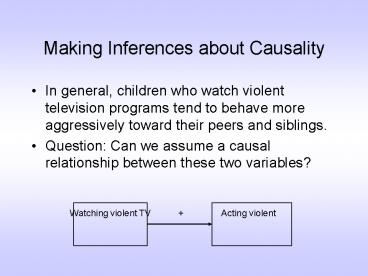Making Inferences about Causality - PowerPoint PPT Presentation
1 / 18
Title:
Making Inferences about Causality
Description:
Although causality generally implies ... view an episode of the Sopranos. view an episode of the Sopranos in which the violent scenes have been edited ... – PowerPoint PPT presentation
Number of Views:28
Avg rating:3.0/5.0
Title: Making Inferences about Causality
1
Making Inferences about Causality
- In general, children who watch violent television
programs tend to behave more aggressively toward
their peers and siblings. - Question Can we assume a causal relationship
between these two variables?
2
Making Inferences about Causality
- Answer not necessarily
- Although causality generally implies correlation,
correlation does not necessarily imply causality. - There are at least three other ways to explain
the correlation between TV viewing and aggressive
behavior.
3
Making Inferences about Causality
- (1) Acting aggressively makes you want to watch
more violent TV.
4
Making Inferences about Causality
- (2) Acting violent makes you want to watch more
TV and watching TV makes you act more violently.
5
Making Inferences about Causality
- (3) A third variable influences both variables,
causing them to be correlated.
6
How can we tease apart these various
possibilities?
- One way to do so is to conduct an experiment
- In an experiment, at least one variable is
manipulated (i.e., systematically varied) by the
researcher in order to study its effects on
another variable.
7
Experimental Research
- Features of an experiment
- (a) At least one variable is manipulated or
varied by the experimenter independent variable
(IV) - (b) The variable presumably affected by the
manipulation is called the dependent variable
(DV) - (c) random assignment to conditions
IV
DV
8
IV
DV
- Independent Variable Watching violent TV
- Levels
- view an episode of the Sopranos
- view an episode of the Sopranos in which the
violent scenes have been edited
9
Confounding Variable
- Confounding variable a variable that influences
the dependent variable and is associated with the
independent variable - When confounding variables are present, we cannot
make a strong inference that the independent
variable causes the dependent variable.
10
Random Assignment
- Why is random assignment important?
- Consider what would happen if we assigned men to
the violent level of the IV and women to the
non-violent level of the IV. - Sex would be correlated with the IV.
11
Random Assignment
- Random assignment to conditions helps to remove
the problem of confounding variables. - When people are randomly assigned to conditions,
we should (in the long run) have equal numbers of
men and women in our two conditions. - As a result, the possible confound (e.g., sex) is
uncorrelated with the independent variable.
12
Random Assignment
- Previously, we had discussed the possibility that
the violence of the family context is a third
variable that might be causing both violent TV
viewing and aggressive behavior. - We could control for this possible confound by
randomly assigning people to violent TV viewing
conditions. - Theoretically, there should be an equal number of
people from violent families in each condition.
13
Confounding Variables and Non-Confounding
Variables
- A variable can exist that has a genuine effect on
the dependent variable but that is uncorrelated
with the independent variable.
14
Confounding Variables and Non-confounding
Variables
Confounding
Non-Confounding
15
Experimental Research
- Between- and within-subjects designs
- between-subjects different people are exposed to
each level of the IV - within-subjects the same people exposed to each
level of the IV
16
Experimental Research
- Pros and cons of between and within designs
- between different people in each condition. They
may differ in certain respects - within same DV assessed many times. Problems
with learning effects and awareness of the
manipulation - counter-balancing balancing the order of
conditions.
17
Counter-balancing
- t1 t2 t3
- Person 1 C1 C2 C3
- Person 2 C1 C3 C2
- Person 3 C2 C1 C3
- Person 4 C2 C3 C1
- Person 5 C3 C1 C2
- Person 6 C3 C2 C1
18
Counter-balancing
- t1 t2 t3
- Group 1 C1 C2 C3
- Group 2 C1 C3 C2
- Group 3 C2 C1 C3
- Group 4 C2 C3 C1
- Group 5 C3 C1 C2
- Group 6 C3 C2 C1





![[READ DOWNLOAD] The Effect: An Introduction to Research Design and Causality PowerPoint PPT Presentation](https://s3.amazonaws.com/images.powershow.com/10087195.th0.jpg?_=20240727042)
![get [PDF] Download The Effect: An Introduction to Research Design and Causality PowerPoint PPT Presentation](https://s3.amazonaws.com/images.powershow.com/10087196.th0.jpg?_=20240727042)
![[READ DOWNLOAD] The Effect: An Introduction to Research Design and Causality PowerPoint PPT Presentation](https://s3.amazonaws.com/images.powershow.com/10088344.th0.jpg?_=20240730019)
![get [PDF] Download The Effect: An Introduction to Research Design and Causality PowerPoint PPT Presentation](https://s3.amazonaws.com/images.powershow.com/10088345.th0.jpg?_=20240730019)






















